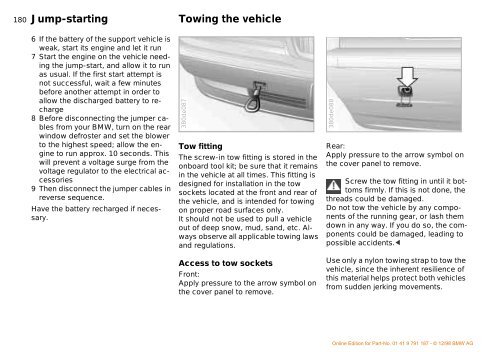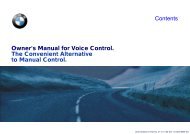Owner's Manual for the vehicle. With a quick reference ... - E38.org
Owner's Manual for the vehicle. With a quick reference ... - E38.org
Owner's Manual for the vehicle. With a quick reference ... - E38.org
You also want an ePaper? Increase the reach of your titles
YUMPU automatically turns print PDFs into web optimized ePapers that Google loves.
180nJump-starting<br />
Towing <strong>the</strong> <strong>vehicle</strong><br />
6 If <strong>the</strong> battery of <strong>the</strong> support <strong>vehicle</strong> is<br />
weak, start its engine and let it run<br />
7 Start <strong>the</strong> engine on <strong>the</strong> <strong>vehicle</strong> needing<br />
<strong>the</strong> jump-start, and allow it to run<br />
as usual. If <strong>the</strong> first start attempt is<br />
not successful, wait a few minutes<br />
be<strong>for</strong>e ano<strong>the</strong>r attempt in order to<br />
allow <strong>the</strong> discharged battery to recharge<br />
8 Be<strong>for</strong>e disconnecting <strong>the</strong> jumper cables<br />
from your BMW, turn on <strong>the</strong> rear<br />
window defroster and set <strong>the</strong> blower<br />
to <strong>the</strong> highest speed; allow <strong>the</strong> engine<br />
to run approx. 10 seconds. This<br />
will prevent a voltage surge from <strong>the</strong><br />
voltage regulator to <strong>the</strong> electrical accessories<br />
9 Then disconnect <strong>the</strong> jumper cables in<br />
reverse sequence.<br />
Have <strong>the</strong> battery recharged if necessary.<br />
380de087<br />
Tow fitting<br />
The screw-in tow fitting is stored in <strong>the</strong><br />
onboard tool kit; be sure that it remains<br />
in <strong>the</strong> <strong>vehicle</strong> at all times. This fitting is<br />
designed <strong>for</strong> installation in <strong>the</strong> tow<br />
sockets located at <strong>the</strong> front and rear of<br />
<strong>the</strong> <strong>vehicle</strong>, and is intended <strong>for</strong> towing<br />
on proper road surfaces only.<br />
It should not be used to pull a <strong>vehicle</strong><br />
out of deep snow, mud, sand, etc. Always<br />
observe all applicable towing laws<br />
and regulations.<br />
Access to tow sockets<br />
Front:<br />
Apply pressure to <strong>the</strong> arrow symbol on<br />
<strong>the</strong> cover panel to remove.<br />
380de088<br />
Rear:<br />
Apply pressure to <strong>the</strong> arrow symbol on<br />
<strong>the</strong> cover panel to remove.<br />
Screw <strong>the</strong> tow fitting in until it bottoms<br />
firmly. If this is not done, <strong>the</strong><br />
threads could be damaged.<br />
Do not tow <strong>the</strong> <strong>vehicle</strong> by any components<br />
of <strong>the</strong> running gear, or lash <strong>the</strong>m<br />
down in any way. If you do so, <strong>the</strong> components<br />
could be damaged, leading to<br />
possible accidents.<<br />
Use only a nylon towing strap to tow <strong>the</strong><br />
<strong>vehicle</strong>, since <strong>the</strong> inherent resilience of<br />
this material helps protect both <strong>vehicle</strong>s<br />
from sudden jerking movements.



